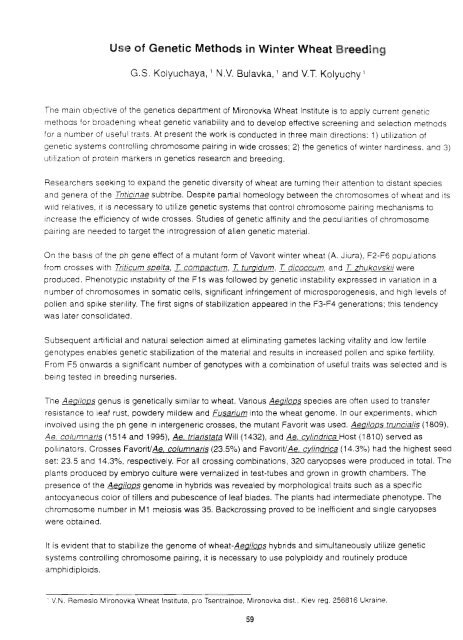Untitled - Search CIMMYT repository
Untitled - Search CIMMYT repository
Untitled - Search CIMMYT repository
You also want an ePaper? Increase the reach of your titles
YUMPU automatically turns print PDFs into web optimized ePapers that Google loves.
Use of Genetic Methods in Winter Wheat BreedingG.S. Kolyuchaya, 1 N.V. Bulavka, 1 and v.T. Kolyuchy 1The main objective of the genetics department of Mironovka Wheat Institute is to apply current geneticmethods for broadening wheat genetic variability and to develop effective screening and selection methodsfor a number of useful traits. At present the work is conducted in three main directions: 1) utilization ofgenetic systems controlling chromosome pairing in wide crosses; 2) the genetics of winter hardiness. and 3)utilization of protein markers In genetics research and breeding.Researchers seeking to expand the genetic diversity of wheat are turning their at1ention to distant speciesand genera of the Triticinae subtribe. Despite partial homeology between the chromosomes of wheat and itswild relatives, it is necessary to utilize genetic systems that control chromosome pairing mechanisms toincrease the efficiency of wide crosses. Studies of genetic affinity and the peculiarities of chromosomepairing are needed to target the introgression of alien genetic material.On the basIs of the ph gene effect of a mutant form of Vavorit winter wheat (A. Jiura), F2-F6 populationsfrom crosses with Triticum soe/ta, T compactum, T turgidum, T dicoccum, and T zhukovskii wereproduced. Phenotypic instability of the F1s was followed by genetic instability expressed in variation in anumber of chromosomes in somatic cells, significant infringement of microsporogenesis, and high levels ofpollen and spike sterility. The first signs of stabilization appeared in the F3-F4 generations; this tendencywas later consolidated.Subsequent artificial and natural selection aimed at eliminating gametes lacking vitality and low fertilegenotypes enables genetic stabilization of the material and results in increased pollen and spike fertility.From F5 onwards a significant number of genotypes with a combination of useful traits was selected and isbeing tested in breeding nurseries.The Aegi/ops genus is genetically similar to wheat. Various Aegi/ops species are often used to transferresistance to leaf rust, powdery mildew and Fusarium into the wheat genome. In our experiments, whichinvolved using the ph gene in intergeneric crosses, the mutant Favorit was used. Aegiloos truncialis (1809),Ae. co/umnaris (1514 and 1995), Ae. triaristata Will (1432), and Ae. cvlindrica Host (1810) served aspollinators. Crosses FavoritiAe. columnaris (23.5%) and FavoritiAe. cylindrica (14.3%) had the highest seedset: 23.5 and 14.3%, respectively. For all crossing combinations, 320 caryopses were produced in total. Theplants produced by embryo culture were vernalized in test-tubes and grown in growth chambers. Thepresence of the Aegilops genome in hybrids was revealed by morphological traits such as a specificantocyaneous color of tillers and pubescence of leaf blades. The plants had intermediate phenotype. Thechromosome number in M1 meiosis was 35. Backcrossing proved to be inefficient and single caryopseswere obtained.It is evident that to stabilize the genome of wheat-Aegilops hybrids and simultaneously utilize geneticsystems controlling chromosome pairing, it is necessary to use polyploidy and routinely produceamphidiploids., V.N. Remeslo Mironovka Wheat Institute, plO Tsentralnoe, Mironovka dis!.. Kiev reg. 256816 Ukraine.59

















